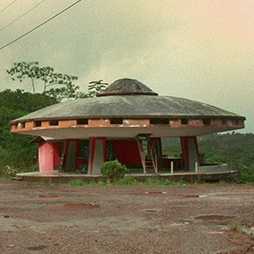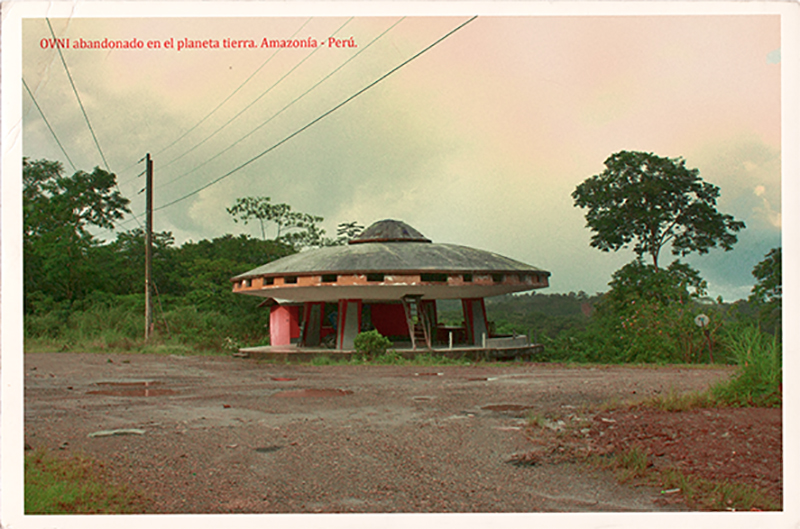
Seven notes on the museum-as-hub
AA.VV.
Re-Shuffle / Notions of an Itinerant Museum
Annandale-on-Hudson:
Center for Curatorial Studies Museum, Bard College, 2006
LECTURAS
a bordo

Christian Bendayán
OVNI abandonado en el planeta Tierra
Amazonía – Perú
De la serie Postales
1919
Inyección de tinta sobre papel
Colección MICROMUSEO
(“al fondo hay sitio”)
SEVEN NOTES
ON THE MUSEUM-AS-HUB
GERARDO MOSQUERA
Museums have always evolved according to changes in art, its production and its circulation. However, as institutions that maintain a conservative nature, museums are usually behind art, trying to match its transformations at a belated pace. Museums have experienced two main structural stages. They began as collections that were shown publicly and permanently. Then space and location acquired greater importance. Later, space became not only a place where objects were exhibited, but, most significantly, where events happened. In contemporary art museums, space is the chief component, since they deal with “living” art. Space links museums to specific contexts, communities and constituencies.
The key issue for contemporary art today is the dramatic expansion of its international circulation in the last twelve years. This tendency will continue in a twofold way. On the one hand, it will develop ever increasing globalized art scenes as a result of the growth of international art networks, events, and global public spheres, together with the activity of emerging cultural subjects coming from all over the world. On the other, it will stimulate a new energy that produces valuable art locally in areas where —for historical, economic and social reasons— one would not expect to see work interesting beyond its local context. Contexts themselves are becoming more global through their interconnection with the world.
Massive urbanization is quickly developing in Africa, Asia and Latin America. As a result, the number of the world’s city-dwellers have doubled since 1975, and it will double again by 2015. Of the thirty-six megalopolises predicted to exist in 2015, thirty will be located in non-Western countries. The cultural implications of this demographic penchant are obvious. And if cities grow full speed all over the Third World, the practice of contemporary art will subsequently continue widening under a more decentralized scheme. The connection between art and city has not evolved very far yet, but will probably indicate a main course of action for artistic practice in the near future.
The museum’s role and mission have lately been under constant debate. These complex discussions include cultural issues, goals, specific approaches, programs, communication strategies, target audiences, relations with communities, and many others. It seems as if the museum, as institution, is having difficulty answering the new problems brought by the broad cultural dynamics of these changing times. Perhaps the new situation is pointing to a third major shift in the museum’s practice, one that will take it from the prevalent space-centered routine, to another, more dynamic endeavor, in which the museum will be a moving activity spread all over the globe: the museum-as-hub. If museums have brought the world into their spaces, perhaps the moment has arrived to launch museums into the world.
The museum as an international hub of artistic activities means a decentralized institution that will simultaneously conceive, curate, and participate in diverse projects in different places worldwide. Its level of involvement should be very flexible, ranging from full conception and organization, to plain moral support. The projects could include exhibitions, events, urban art, workshops, gatherings, and art endeavors and programs. They could be formulated and undertaken entirely by the museum or, more likely, consist of joint ventures and collaborations with other institutions, informal groups, or individuals, with varying degrees of commitment. The results could have full or partial manifestations in the museum’s space, or have none. The space, actually, will tend to disappear.
The museum-as-hub would develop an international network of exchanges and activities, with which it would be dynamically connected, participating in a flux of information, projects and actions. Like online communities, the museum would have its own expanding network of artists, curators, educators, collectors, specialists, and institutions of the art field throughout the world. This community would be held together by a sharing of ideas, positions and interests, and by a concrete commitment to mutually beneficial interchanges and projects.
The museum-as-hub is an attempt to match new developments in a changing world, with the museum participating at the very spot where art practices take place. For the museum, as for many other things, the future will mean an increasingly global and decentralized activity.
